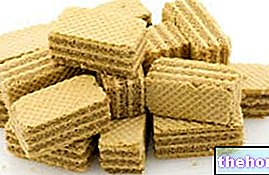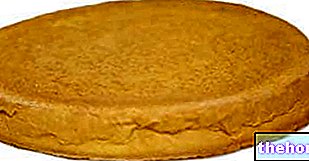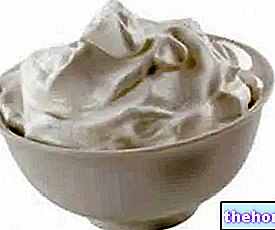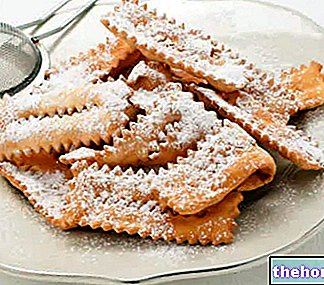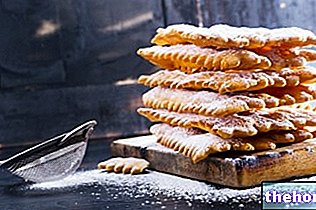Generality
White chocolate is a sweet food obtained from the processing of ingredients such as cocoa butter, sucrose and cow's milk or its derivatives (mainly powdered milk).

Cocoa butter: it is a fatty substance obtained by processing cocoa beans. This ingredient confers the taste and organoleptic characteristics typical of the product, in which (by law) it must be present in minimum quantities of 20% (in some white chocolates there are percentages that even reach 45%). In addition to white chocolate , Cocoa butter is also present in other types of chocolate, lipsticks, cosmetics and some drugs.
- Definition of White Chocolate (DIRECTIVE 2000/36 / EC): The product obtained from cocoa butter, milk or milk products and sugars, and which contains not less than 20% cocoa butter and 14% milk dry matter obtained from the partial or total dehydration of whole milk, partially or totally skimmed milk, cream, partially or totally dehydrated cream, butter or milk fat; the latter must be present in quantities of at least 3.5%
Milk powder: it is a product obtained from the dehydration of cow's milk; in white chocolate it must not be less than 14% (both to characterize the taste and to ensure the right consistency).
Sucrose: o table sugar, it is always present in white chocolate since there are NO types of bitter or unsweetened white chocolate on the market.
Regarding its composition, white chocolate is (like milk chocolate) more difficult to melt than dark chocolate but it can still be used in preparations such as mousses, sauces and glazes.
White Chocolate in a Cup - Hot Chocolate
Problems with playing the video? Reload the video from youtube.
- Go to the Video Page
- Go to the Video Recipes Section
- Watch the video on youtube
Nutritional characteristics
While cocoa powder and dark chocolate - thanks to the high quantity of molecules polyphenolic - they are considered useful foods for the body, white chocolate does NOT have any antioxidant value. However, for its part, white chocolate does NOT contain molecules nervine stimulants (such as theobromine), instead present in cocoa and black chocolate. For this reason, just like the milk one, it is more suitable for feeding children and people sensitive to caffeine.
White chocolate is rich in simple sugars (sucrose), an aspect that makes it unsuitable for the diet of those suffering from hypertriglyceridemia. At the same time, it contains high quantities of fatty acids which contribute to significantly increasing the overall energy intake; Fortunately, while for some types of black chocolate the addition of hydrogenated fats is allowed, these are NOT allowed in white chocolate. This does not mean that most of the lipids contained in it are saturated, therefore not suitable for food hypercholesterolemia.
White chocolate, containing powdered milk, is not recommended in case of lactose intolerance or allergy to cow's milk proteins; on the other hand, thanks to this ingredient, it reaches remarkable concentrations of calcium, riboflavin (vitamin B2) and retinol equivalent (pro-vitamin A) compared to black chocolate.
Homemade white chocolate pastries
Creating delicacies worthy of the most renowned pastry shops with your own hands is not that difficult. Just follow the advice of our Personal Cooker, Alice, who in this video recipe shows how to prepare black and white chocolate pastries.
Chocolate pastries
Problems with playing the video? Reload the video from youtube.
- Go to the Video Page
- Go to the Video Recipes Section
- Watch the video on youtube
Other Foods - Sweets Aspic Cantucci Caramel Candied Citron Chocolate White Chocolate Codette Chantilly Cream Custard Crepes Ice Cream Granita Ice Cream Jam and Jam Marshmallow Marzipan Honey Mustard Nutella Sponge Cake Pandoro Panettone Shortcrust Pastry Sorbet Strudel Nougat Wafer Zabaione Iced Sugar OTHER ITEMS Alcoholic Alcohol Categories Meat Cereals and derivatives Sweeteners Sweets Offal Fruit Dried fruit Milk and derivatives Legumes Oils and fats Fish and fishery products Salami Spices Vegetables Health recipes Appetizers Bread, Pizza and Brioche First courses Second courses Vegetables and Salads Sweets and Desserts Ice creams and sorbets Syrups, Spirits and grappas Basic Preparations ---- In the Kitchen with Leftovers Carnival Recipes Christmas Recipes Diet Recipes Light Recipes Women's Day, Mum, Dad Functional Recipes International Recipes Easter Recipes Recipes for Celiacs Recipes for Diabetics Recipes for the Holidays Recipes for S an Valentino Vegetarian Recipes Protein Recipes Regional Recipes Vegan Recipes

